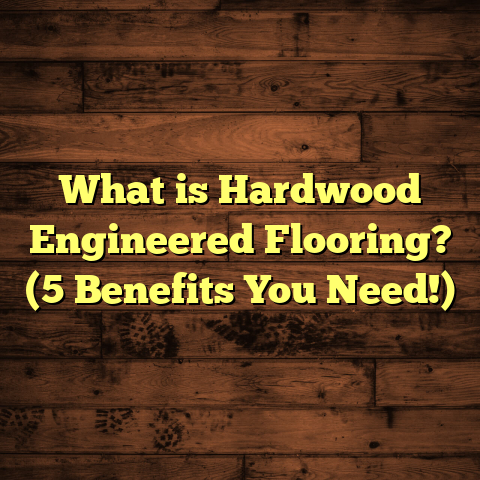What is Scandi Flooring? (5 Reasons to Love This Trend)
When I first started renovating homes, I quickly realized that flooring was one of those elements that could make or break a space — and even affect how much you could sell the house for later. Over the years, one style caught my attention again and again for its timeless charm and growing popularity: Scandinavian flooring, or “Scandi flooring” for short. If you’ve been thinking about upgrading your floors or curious why this trend keeps popping up in design magazines and real estate listings, let me share what I know.
I’ll walk you through what Scandi flooring is, why it’s so beloved, the technical details behind it, and the reasons why it consistently adds value to your home. Plus, I’ll spill some tips on managing costs and maintenance based on my hands-on experience and research. Grab a cup of coffee, and let’s chat about why I think Scandi flooring could be your next best home improvement move.
What is Scandi Flooring?
At its core, Scandi flooring reflects the broad design principles that evolved in the Nordic countries — Denmark, Norway, Sweden, Finland, and Iceland. The Scandinavian design approach champions simplicity, natural materials, functionality, and light-filled spaces. So when we talk about Scandi flooring, we’re usually referring to wood floors that embrace these values.
Characteristics of Scandi Flooring
- Light-colors dominate — think white oak, pale pine, bleached ash, or light birch.
- Natural wood grain is visible but not overly glossy or shiny; finishes tend to be matte or satin.
- Clean and minimalistic plank designs with often wider boards to enhance a sense of openness.
- Neutral tones that provide a calm backdrop, allowing furniture and décor to shine.
- Engineered wood is common due to its durability and performance in fluctuating Nordic climates.
This style is more than just a color choice. It’s about creating an atmosphere that feels airy, warm, and inviting without clutter or heavy ornamentation. The floor acts as an understated canvas that complements everything from sleek modern furniture to cozy rustic pieces.
How Scandi Flooring is Made: Technical Insights
Most authentic Scandi floors are made using engineered hardwood rather than solid boards. Why? Because engineered wood combines the beauty of real wood on top with a stable base underneath — usually plywood or high-density fiberboard (HDF). This layered construction reduces risks like warping or twisting that solid planks might suffer in humidity or temperature changes.
Here’s a quick rundown of typical specs for engineered Scandi flooring:
| Specification | Typical Range |
|---|---|
| Total Thickness | 14mm to 20mm |
| Wear Layer Thickness | 2mm to 6mm real hardwood veneer |
| Board Width | 120mm to 180mm |
| Board Length | 1200mm to 2200mm |
| Finish Type | UV-cured matte or satin finish |
| Installation Method | Click-lock floating or glue-down |
| Wood Species | White oak, pine, ash, birch |
The finishes used are often natural oils or water-based lacquers that protect the wood while keeping that natural matte look. Oil finishes penetrate the wood surface offering a soft feel and can be spot-repaired if scratched. Water-based lacquers dry clear with minimal odor and are more environmentally friendly.
Sustainable Practices
Many Scandinavian manufacturers are leaders in sustainability. They source timber from forests certified by organizations like FSC (Forest Stewardship Council) — meaning the wood comes from responsibly managed forests that protect ecosystems and biodiversity.
Also worth noting: low-VOC (volatile organic compound) finishes are common in this market, which means better indoor air quality for your home. This eco-conscious approach aligns with the minimalist lifestyle values prevalent in Nordic culture.
Why I Love Scandi Flooring: Five Reasons That Matter
Over the years of installing floors and remodeling homes, I’ve seen many trends come and go. But Scandi flooring has stuck around because it hits several important marks for homeowners:
1. It Increases Resale Value
You might ask, why does flooring impact resale value so much? Well, floors cover the largest square footage in a home. They shape first impressions.
Studies back this up. According to the National Association of Realtors (NAR) in their 2023
Housing Trends report:
- Homes with light hardwood floors sold for an average of 5-7% more than those with dark or carpeted floors.
- Properties featuring engineered wood flooring had a higher buyer interest due to perceived durability.
- Buyers ranked flooring condition as one of the top three factors influencing purchase decisions.
In my own projects, houses with freshly installed Scandi floors often attracted more visits during open houses — sometimes doubling foot traffic compared to similar homes without such upgrades.
One client told me: “The light oak floor made my living room feel so much bigger and brighter. When we put the house on the market last year, it sold in less than two weeks.” That kind of feedback is priceless.
2. Timelessness That Fits Any Décor
Trends come and go fast these days — but Scandinavian flooring has proven its staying power. Its neutral color palette and simple grain patterns mean it blends well with evolving décor styles.
I’ve seen clients switch from mid-century modern furniture to boho chic or coastal themes without ever needing to change their floors. The floor just adapts.
The secret lies in how these pale woods reflect light and create a versatile backdrop. Light colors soften contrasts and balance bold colors or textures in furnishings.
A personal anecdote: After installing Scandi floors in my own house five years ago, I’ve redecorated three times without once feeling the need to replace or refinish the floor. It’s just aged beautifully with minimal maintenance.
3. Maximizes Natural Light & Space Perception
If you live somewhere with shorter daylight hours during winter months (hello Northern Hemisphere!), you know how precious natural light becomes.
Light-colored floors bounce daylight around rooms rather than absorbing it like darker woods do. This can increase perceived brightness by up to 20%, according to research from the Lighting Research Center.
In smaller spaces especially, pale floors create an illusion of openness. That’s why many Scandinavian apartments and houses use light wood extensively — it makes compact areas feel larger and airier.
I remember working on an urban studio renovation where we installed bleached ash floors. The owner was amazed how much “bigger” her room felt afterward without changing any walls or windows.
4. Durability Meets Low Maintenance
One misconception I often hear: “Light floors must show dirt more.” Actually, many Scandi floors are finished with matte or natural oil coatings that do a great job hiding dust and minor scratches compared to glossy finishes.
Engineered wood construction adds dimensional stability — meaning less warping or cupping over time compared to solid hardwoods.
From my experience:
- A family with kids and pets I worked with had pale oak floors that held up beautifully for over six years.
- Spot repairs were easy thanks to the oil finish allowing targeted refinishing.
- Simple sweeping and occasional damp mopping kept things clean without special cleaners.
If you want more longevity, consider choosing a wear layer of at least 3mm on engineered boards — this allows for sanding down and refinishing multiple times over the floor’s lifetime.
5. Environmentally Friendly Options Abound
Sustainability isn’t just a buzzword in Scandinavian design; it’s a way of life reflected even in flooring production.
Many manufacturers follow stringent rules:
- Wood sourced from FSC-certified forests ensures no illegal logging.
- Water-based finishes reduce harmful chemical emissions.
- Production processes often use renewable energy sources.
- Waste materials are recycled or repurposed internally.
When I help clients pick floors today, I highlight these eco-certifications because buyers increasingly care about health and environmental impact.
Choosing a sustainable floor also means you’re investing in something built responsibly — which feels good beyond aesthetics or price tags.
More Than Style: The Science Behind Scandi Flooring
You might wonder what happens behind the scenes during manufacturing that makes these floors both beautiful and reliable.
Engineered Wood Manufacturing Process
Engineered wood is produced through a multi-step process:
- Log Selection: High-quality logs chosen based on species and grain patterns.
- Veneer Slicing: Thin layers (veneer) sliced from logs using rotary peeling or slicing machines.
- Core Layer Preparation: Multiple plywood or HDF layers cut accurately for stability.
- Gluing & Pressing: Veneer bonded atop core layers with strong adhesives under heat and pressure.
- Cutting & Profiling: Boards cut to size; edges milled with grooves for click-lock installation.
- Sanding & Finishing: Surfaces sanded smooth; finishes applied (oil/lacquer) then UV-cured for hardness.
- Quality Control: Boards checked visually and mechanically for defects before packaging.
This process ensures engineered wood behaves predictably in different climates while keeping the authentic wood look on top.
Why Engineered Over Solid Wood?
Solid hardwood is beautiful but can expand/contract significantly with moisture changes — leading to gaps or buckling if not carefully installed and maintained.
Engineered wood reduces this risk thanks to its cross-layered core construction resisting dimensional changes better.
For example:
- Engineered boards expand/contracts about 1/4 as much as solid hardwood under humidity fluctuations.
- This makes them suitable for installation over concrete slabs or radiant heating systems where solid wood might fail.
Pricing & Budgeting: How I Plan Costs Using FloorTally
Estimating floor installation costs can get complicated fast — you have material prices varying by species and quality, labor rates based on region and skill level, plus prep work like subfloor repairs or removal of old flooring.
I used to spend hours juggling spreadsheets until I found tools like FloorTally helpful for streamlining quotes.
Here’s what I appreciate most about FloorTally:
- It calculates material costs based on local prices.
- Labor costs factor in regional wage averages.
- Waste allowance is added automatically (usually 5% for engineered wood).
- You can customize inputs like room size, plank width/length, installation type (floating vs glued).
- It provides clear cost breakdowns so clients understand where their money goes.
For example, say you want to install 600 sq ft of white oak engineered flooring:
- Materials: $8/sq ft (high-quality white oak)
- Labor: $4/sq ft (including prep)
- Waste factor: 5%
FloorTally estimates total cost around $7,560 — close to actual bids I’ve gotten locally. This accuracy helps me set realistic expectations upfront and avoid surprises later.
Installation Tips & Common Challenges
If you’re thinking about DIY installation or just want to know what professionals deal with during Scandi floor fitting, here’s what you should keep in mind:
Subfloor Preparation Matters
Scandi floors perform best on flat, clean subfloors free from moisture issues. Unevenness greater than 3mm over a meter can cause clicking joints not to lock properly or lead to squeaking later on.
I always recommend testing moisture levels before installation — especially over concrete slabs — using moisture meters or calcium chloride tests.
Acclimatizing Wood
Engineered wood needs time (usually 48–72 hours) inside the installation space before fitting so it adjusts to ambient humidity and temperature. Skipping this step often results in gaps or buckling after installation.
Choosing Installation Method
Floating click-lock systems are popular because they’re faster and less messy but glued-down floors offer better sound insulation and stability in high traffic areas.
For Scandi-style engineered boards with wide planks (150+ mm), glue-down installation can reduce movement noises and improve longevity.
Dealing with Color Variation
Natural wood varies plank-to-plank; randomizing boards during installation creates a more authentic look rather than grouping similar grains or colors together.
Real-Life Case Study: Coastal Home Renovation
A few months ago, I worked with a couple renovating their beach house near Maine. They wanted bright floors that felt fresh but could handle salty air humidity.
We chose engineered white oak with an oil finish made by a Scandinavian company known for sustainable practices. The boards were about 180mm wide for that spacious feel.
The benefits were immediate:
- The interior felt open despite limited windows.
- Salt air didn’t cause warping after three months exposure.
- Maintenance was straightforward — occasional sweeping kept sand off.
- The couple reported increased enjoyment of their home’s aesthetic daily.
When they later listed the property for sale, they mentioned several buyers specifically complimented the flooring choice as a reason they were interested.
Maintenance Insights from My Experience
Scandi floors require simple care routines to stay looking great:
- Sweep or vacuum regularly using soft bristle attachments.
- Use damp mops with pH-neutral cleaners designed for hardwood; avoid soaking water.
- Apply maintenance oil once per year if oiled finish is used to refresh surface protection.
- Place felt pads under furniture legs to prevent scratches.
- Immediately wipe up spills to avoid staining light wood.
I’ve guided clients through refinishing projects where after 10+ years their floors were sanded lightly and re-oiled — restoring original beauty easily without full replacement.
FAQs About Scandinavian Flooring
Q: Can I install Scandi flooring over radiant heat?
A: Yes! Engineered wood performs well with underfloor heating due to dimensional stability. Just ensure manufacturer guidelines for max temperature compliance are followed (usually around 27°C / 80°F).
Q: Is it suitable for high traffic areas?
A: Absolutely. Choose boards with thicker wear layers (4mm+) and durable finishes like UV-cured lacquers for longevity in busy homes.
Q: How does cost compare with other hardwoods?
A: Prices vary widely but expect premium white oak engineered boards typical of Scandi styles to range from $6–$12 per sq ft installed depending on quality and region.
Q: Are wider planks better?
A: Wider planks enhance the open look typical of Nordic interiors but can be slightly more prone to movement if subfloor prep isn’t perfect.
Final Thoughts
Scandinavian flooring embodies simplicity paired with quality—making it one of the smartest choices if you want your home to feel fresh yet timeless while increasing its market value.
From my personal experience installing it in various homes and seeing client satisfaction soar, it’s clear this style isn’t just hype. It’s practical beauty backed by solid materials science and sustainable practices.
Whether you’re renovating your own space or preparing a property for sale, considering Scandi flooring might just be the difference-maker you need.
If you want me to help you figure out which exact type fits your needs—or walk you through installation details—just ask! Flooring is my passion, especially when it involves something as elegant yet functional as Scandinavian design.
That’s my deep take on Scandi flooring — hope this helps you get a clear picture of why this style keeps winning hearts (and offers great value too!).





